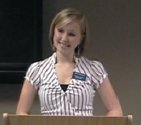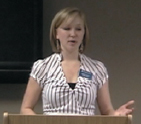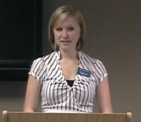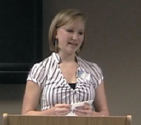Sample Speech: The Dance of Life, Ashley White
SAMPLE VISUALLY ANNOTATED INTRODUCTORY SPEECH
The Dance of Life
ASHLEY WHITE

 Even though the speaker’s topic is herself, she draws the audience in with the personal pronoun “We.” This captures the audience’s attention and makes listeners feel included. The speaker’s use of a series of rhetorical questions is a dramatic way to introduce her thesis—the search for identity and purpose in life—and to preview the main points.
Even though the speaker’s topic is herself, she draws the audience in with the personal pronoun “We.” This captures the audience’s attention and makes listeners feel included. The speaker’s use of a series of rhetorical questions is a dramatic way to introduce her thesis—the search for identity and purpose in life—and to preview the main points.
We are on a lifelong journey to find our identity. On this journey, we look for those things that make us unique, that bring us success, and that hold us back, and we discover how they define our personality. We set standards for ourselves and observe our boundaries. We take so many extraordinary measures, but when exactly are we supposed to discover who we are? Is there a specific moment? Is there an initiation age? Is it ever certain? What happens if what defines us must suddenly be let go? How do we find new purpose with what is left? 

 The speaker’s first main point introduces dance as her passion.
The speaker’s first main point introduces dance as her passion.
I have always identified myself as a dancer. Since age three I have been in dance classes, but since birth I have danced. It is not a path for the faint of heart, and yet seldom are dancers taken very seriously. Few people outside of the discipline understand the commitment, the scrutiny, the self-sacrifice, the physical and emotional pain—and the unspeakable joy—that dance affords its chosen ones. Dance truly does offer an inexpressible enjoyment, whether performed in the classroom, in rehearsal, or on stage. It becomes more than a hobby. It is self-defining. 
 The speaker introduces her second main point, that she developed scoliosis. She adds drama by signaling, in story form, that something has gone wrong with her chosen path.
The speaker introduces her second main point, that she developed scoliosis. She adds drama by signaling, in story form, that something has gone wrong with her chosen path.

My dance teacher was the first to notice the curve, and then I was formally diagnosed with scoliosis at the age of ten. Scoliosis is a lateral curvature of the spine ranging from slight to severe. It often gets worse during adolescent growth and stops worsening when growth stops. It affects girls and boys, but it is not life threatening. 


At eleven, I was wearing a back brace at night, and at twelve, both day and night. Adolescence is a difficult time to deal with any anomaly. During a time when everyone was trying to fit the norm, the brace made me feel different. This caused me much anxiety and depression. Dance class was my only time of liberation, which made my desire to dance even stronger.
I stopped wearing the brace once I got to high school because I had stopped growing; but during my second semester of college I received troubling news. My curve had worsened by fifteen degrees in four years, and it was time to consider surgery. The doctor informed me from the start that, with the surgery, dancing professionally would not be likely, although I would be able to dance recreationally. He also advised that without the surgery, my spine would continue to curve, leaving me with lifelong discomfort and misshapenness. I went through with the surgery in July 2007. The doctors placed two titanium rods on either side of my spine, held in place by hooks. Two months later, I am still recovering and have little pain. 

I am thankful for my overall health, for the success of the surgery, that one day soon I will dance again, and that amongst all this emotional turmoil, I have found a new passion. This art is expressed in the kitchen, not in the dance studio, and my training begins here at Johnson and Wales University. Cooking and dancing require many of the same skills: discipline, artistry, technique.

However, knowledge of food can also provide me with endless career opportunities, where as a dancer I might never have worked steadily. This transition of redefining myself has been a difficult one, and I have learned that it is actually an ongoing one. Being in touch with oneself requires constant learning, redefining, and reapplying, and not just being dedicated to a single interest. This lifelong journey I am on? I know now that this is just the beginning of finding my own identity. 
 In a surprise twist, the speaker tells us that she has found a new passion. This is her third main point.
In a surprise twist, the speaker tells us that she has found a new passion. This is her third main point.
 The speaker concludes by returning to the theme she introduced in her introduction: the quest for identity.
The speaker concludes by returning to the theme she introduced in her introduction: the quest for identity.